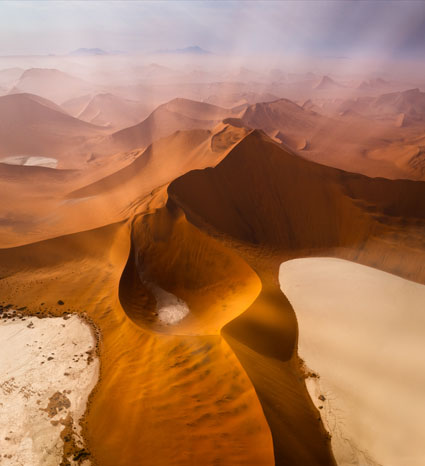
Try New Things – The Story Behind The Image
Illumination II, Sossusvlei, Namibia 2012
In 2010, during my third trip to one of the oldest desert’s in the world, Namibia’s Sossusvlei dune field, I enjoyed one of the most sublime hours of my life, from a helicopter. Moments of grace like this fill you with reverence for the miracle world we live in and a deep abiding gratitude to be a part of it all. I was prepared for it, but nonetheless surprised.
Before arriving, to plan where to go and how to maximize my time this magnificent dune field, I had done a considerable amount of virtual aerial research with Google Earth, zooming and panning images made from the combination of thousands of satellite images at various magnifications, to familiarize myself with where it started and stopped, how it changed in character, and the relative location of landmarks such as the dunes Big Mama and Big Daddy and the famous clay playa Deadvlei. This was a new way of scouting a location for me and it paid dividends making the limited time I had there more efficient and productive.
None of that could have prepared me for the changing angle of light or weather. On site, I had to assess the impact of current conditions. We were on the second flight of the day, an hour after sunrise. All week long, the air was filled with dust from far off sandstorms that scattered the rays of the sun, permeating the sky with a white gold light. Was this a liability or an asset? How could I make it one and not another?
Even at an altitude of 3,000 feet, twice the height of the largest dunes, I found I couldn’t fit the vast dune field into my viewfinder. So I improvised and started making multi-shot exposures for panoramic stitches while moving. It seemed like a bold move, if the two or three shots did not merge successfully then both would be lost. Then, one of my companions, made an even bolder move, requesting we do a 360-degree stationary rotation so that he could make a panoramic image of the entire dune field. Would it work? To my delight both methods worked.
Neither experiment would have been successful were it not for new image processing software that provided better image stitching capabilities. (Not long ago, it wouldn’t even have been possible to convincingly combine two separate exposures.) More new image processing features aided the final realization of this image. I used new lens profile corrections, designed to remove optical distortions, to expressively distort the image. Quite different than a change in angle of view, which reveals and obscures information, these distortions offered complementary but distinctly different visual effects, changing relative proportions and spatial relationships within the image. This furthered my ongoing experiments to compare and contrast the two and so learn to fully utilize them in tandem with one another intuitively.
Ever since that day, I don’t see things in the same ways. Now I also see in new ways. It’s important to try new things. Trying new things stimulates new growth.
Questions
How do new developments change your experience?
How do new developments change your thinking?
How do new developments change your actions?
How can you use new developments to innovate?
Which new developments are likely to impact your creations most?
Find out more about this image here.
View more related images here.
Read more The Stories Behind The Images here.



No Comments